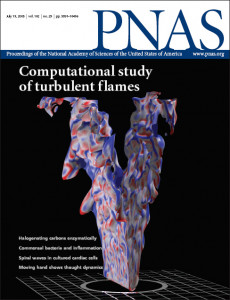Groundbreaking Combustion Research Featured on Cover of PNAS Journal
September 8, 2005
Computational and combustion scientists at the U.S. Department of Energy’s Lawrence Berkeley National Laboratory have earned the cover article in the July 19, 2005 Proceedings of the National Academy of Sciences with their unparalleled computer simulation of turbulent flames.
The research by scientists in Berkeley Lab’s Center for Computational Sciences and Engineering and the Environmental Energy Technologies Division has led to a three-dimensional combustion simulation of unmatched accuracy, a simulation that closely matches conditions found in laboratory combustion experiment.
“Although collaborations between computational scientists and experimentalists are becoming increasingly common, the results from this project clearly demonstrate how scientific computing is coming into its own as an essential component of scientific discovery,” said Horst Simon, Associate Laboratory Director for Computing Sciences at Berkeley Lab. “The simulation is unprecedented in several aspects – the number of chemical species included, the number of chemical processes modeled and the overall size of the flame – which is three orders of magnitude larger than previous efforts. This is truly breakthrough computational science.”
The article, written by John B. Bell, Marc S. Day, Ian G. Shepherd, Matthew R. Johnson, Robert K. Cheng‡, Joseph F. Grcar, Vincent E. Beckner and Michael J. Lijewski, described the simulation of “a laboratory-scale turbulent rod-stabilized premixed methane V-flame. This simulation, which models a full laboratory-scale flame by using detailed chemistry and transport, treats a domain more than three orders of magnitude larger in volume than that of any previous efforts and represents a major increment in simulation complexity.”
The LBNL combustion simulations use a different mathematical approach than has been typically used. Most other combustion simulations are direct numerical simulations, which are very compute-intensive. Because of this, such simulations have been limited to only two dimensions and on a small scale.
The LBNL team has developed an algorithmic approach called an “adaptive low Mach number model,” which strips away relatively unimportant components of the simulation and focuses the computing resources on the most important processes. These algorithmic improvements over the past five years have slashed computational costs for combustion simulations by a factor of 10,000. Even so, the simulation requires substantial computing power – the group ran their application for about 1,000 hours on 256 processors of the IBM SP supercomputer at DOE’s National Energy Research Scientific Computing Center.
The code allows the researchers to model a flame about 12 cm in height and consisting of 80 chemical species and more than 300 chemical processes.
The more efficient method for conducting the simulation was developed in part under DOE’s Scientific Discovery through Advanced Computation (SciDAC) program as part of the Algorithmic and Software Framework for Applied Partial Differential Equations: The goal is to develop a high-performance framework for solving partial differential equations arising from problems in magnetic fusion, accelerator design and combustion – key mission areas for the DOE. The same mathematical and computing tools are also being used to study supernovae.
The research is funded by the Office of Basic Energy Sciences in DOE’s Office of Science. The work also received support from Cristina Siegerist and Wes Bethel of LBNL’s Visualization Group.
The Center for Computational Sciences and Engineering (http://seesar.lbl.gov/ccse/index.html) is part of the Computational Research Division (http://crd.lbl.gov/index.html) at LBNL. Berkeley Lab is a U.S. Department of Energy national laboratory located in Berkeley, California. It conducts unclassified scientific research and is managed by the University of California. Learn more at <http://www.lbl.gov>.
About Berkeley Lab
Founded in 1931 on the belief that the biggest scientific challenges are best addressed by teams, Lawrence Berkeley National Laboratory and its scientists have been recognized with 16 Nobel Prizes. Today, Berkeley Lab researchers develop sustainable energy and environmental solutions, create useful new materials, advance the frontiers of computing, and probe the mysteries of life, matter, and the universe. Scientists from around the world rely on the Lab’s facilities for their own discovery science. Berkeley Lab is a multiprogram national laboratory, managed by the University of California for the U.S. Department of Energy’s Office of Science.
DOE’s Office of Science is the single largest supporter of basic research in the physical sciences in the United States, and is working to address some of the most pressing challenges of our time. For more information, please visit energy.gov/science.










